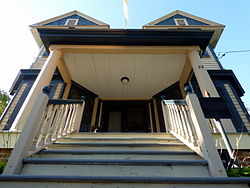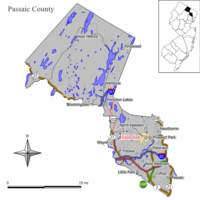Haledon, New Jersey
| Haledon, New Jersey | |
|---|---|
| Borough | |
| Borough of Haledon | |

|
|
 Map of Haledon in Passaic County. Inset: Location of Passaic County highlighted in the State of New Jersey. |
|
 Census Bureau map of Haledon, New Jersey |
|
| Coordinates: 40°56′13″N 74°11′20″W / 40.936989°N 74.188867°WCoordinates: 40°56′13″N 74°11′20″W / 40.936989°N 74.188867°W | |
| Country |
|
| State |
|
| County | Passaic |
| Incorporated | May 21, 1908 |
| Government | |
| • Type | Borough |
| • Body | Borough Council |
| • Mayor | Domenick Stampone (D, term ends December 31, 2018) |
| • Administrator (acting) / clerk | Allan R. Susen |
| Area | |
| • Total | 1.156 sq mi (2.993 km2) |
| • Land | 1.155 sq mi (2.991 km2) |
| • Water | 0.001 sq mi (0.003 km2) 0.08% |
| Area rank | 491st of 566 in state 15th of 16 in county |
| Elevation | 217 ft (66 m) |
| Population (2010 Census) | |
| • Total | 8,318 |
| • Estimate (2015) | 8,451 |
| • Rank | 277th of 566 in state 14th of 16 in county |
| • Density | 7,203.9/sq mi (2,781.4/km2) |
| • Density rank | 56th of 566 in state 5th of 16 in county |
| Time zone | Eastern (EST) (UTC-5) |
| • Summer (DST) | Eastern (EDT) (UTC-4) |
| ZIP codes | 07508, 07538 |
| Area code(s) | 973 |
| FIPS code | 3403129070 |
| GNIS feature ID | 0885240 |
| Website | www |
Haledon (pronounced HALE-dun) is a borough in Passaic County, New Jersey, United States. As of the 2010 United States Census, the borough's population was 8,318, reflecting an increase of 66 (+0.8%) from the 8,252 counted in the 2000 Census, which had in turn increased by 1,301 (+18.7%) from the 6,951 counted in the 1990 Census.
Haledon was incorporated as a borough by an act of the New Jersey Legislature on April 8, 1908, replacing the now-defunct Manchester Township, based on the results of a referendum held on May 21, 1908.
Haledon developed along the northern side of the industrial city of Paterson, New Jersey. It was settled by farmers with colonial Dutch heritage including the Van Riper, Berdan, Banta, Post and Zabriskie families. Prior to the Civil War they were joined by the Roe, Leonard and Stansfield families, who helped establish St. Mary's Episcopal Church and leading businesses including a general store and the Leonard Wax Company.
The area became a streetcar suburb of Paterson in the years following the Civil War, with the central area known as Haledon, while the area surrounding the large pond along High Mountain Road was called Oldham. The Paterson and Haledon Horse Rail Road Company, formed in 1871, laid trolley tracks from Paterson along the current-day Belmont Avenue, which were electrified by 1888. Many of the trolley company's owners were among the founders of the Cedar Cliff Land Company, which bought up large portions of the area, and the street names in the borough reflect these industrialists and businessmen: Morrissee, Hoxey, Van Dyke, John Ryle and Barbour. The flat, lower part of the community was laid out in city-sized lots of 25' by 100' while the hillsides were plated as sites for larger Victorian "villas" for such individuals as Vice President Garret A. Hobart (now the location of William Paterson University) and the Barbour family of linen flax manufacturers. Haledon's villa development was always rather limited and throughout much of the 20th century Haledon was a typical blue-collar community set by the small property sizes planned by the Cedar Cliff Land Company. A never-constructed grand hotel was planned for the highest point of the community above the intersection of the current day Central and West Haledon Avenues. The Cedar Cliff Land Company ran newspaper advertisements targeted at upwardly mobile immigrants who worked in Paterson's silk industry, offering the city-sized lots for sale at auctions (with free lunches and brass bands) held at St. Mary's Parish Hall, and also opened the Cedar Cliff Silk Mill, which became one of several silk mills in the community. The residential appeal of Haledon was to escape the crowded industrial city and still have access to the textile mills by using the trolley. As a result of the land sales of Cedar Cliff Land Company and also of independent landowner William Bushmann, the town was settled by immigrants who came as skilled workers from textile centers in Europe.
...
Wikipedia
